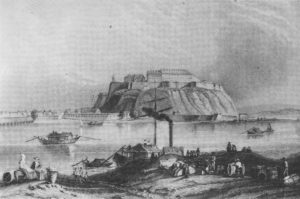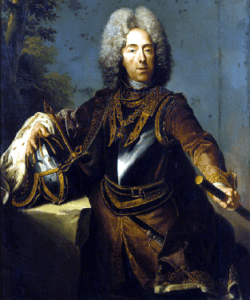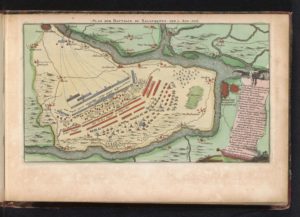
The Battle of Petrovaradin and a Tardy Death Warrant
The Vojvodina town of Petrovaradin, now part of Novi Sad, Serbia, was first settled in 4,500 BC during the Stone Age. Since that time, it was the scene of battles between great and regional powers over a dozen times. In a way, it exemplifies the fortunes of the Balkans themselves, caught between shifting alliances and armies, sometimes of Balkan natives, but often of outside, conquering powers. The first several settlement were peaceful and long term. The Celts conquered the town when they moved into the area in 300 BC. The Romans wrested control from the Celts in the first century BC. After that, the invasions came quickly a frequently. The Romans were evicted by the Ostogoth, Gepids, and Lombards. In the 400s, the Byzantium occupied and expanded the town, before being forced out by Avars, Franks, Pannonian Slavs, and other local tribes, before retaking it and being forced out by Hungary.

By 1526, the Ottomans had taken the town from the Hungarians. Approximately 150 years later, in the 1683-1699 War with the Ottomans, the Hungarians returned under the Habsburgs and retook the town, lost it briefly, and retook it again. The town was small during these many trials, but obviously important, and contained a fortress, which did not seem to be much impediment to being conquered.
In 1716, Ottoman Grand Vizier Silahlar (Arms Bearer) Damat (Royal Bridegroom) Ali Pasha, was committed to changing the status quo for Petrovaradin, and the whole region. Ali was married to the daughter of Sultan Ahmed III and had grand ambitions. After becoming Grand Vizier in 1713, he started on the path to war in the Balkans. The Venetians were giving shelter to rebels from Montenegro an Herzegovina in Morea, which gave Ali the excuse he need to invade. In 1715, Ali swiftly conquered Morea, which had been lost to Venice in 1699. The Venetians warned the Habsburg Monarchy that war was again coming to the Military Frontier, and to be prepared.
At that time, Petrovaradin was part of the Habsburg Military Frontier, an area which has shifted from conventional military garrisons in the 17th century to protect against Ottoman incursions, into a “Soldier-Settler” community system. Habsburg leadership encouraged Serb, Croat, German, Vlach, and other colonists to come into the area to serve as defenders, primarily by giving them land grants, religious freedom, and favorable tax rates. These Frontiersman, or Grenzers, had a vested reason to stand and fight for their lands and their homes, and were experts in local terrain and conditions. Petrovaradin was under Slavonia General Command with an 8,000 man regiment garrisoned in the Petrovaradin Fortress.
In late July 1716, Ali assembled a massive army of 150,000 to 160,000 men in Belgrade. This army included 40,000 elite Janissaries to invade the Habsburg Military Frontier. The Janissaries were former Christians from the Balkans taken as children to be enslaved under the devsirme system, so many understood the local languages and customs. The Ottoman Army also marched with a large number of professional cavalry troops, as well as anti-Habsburg Hungarian cavalry, the Kurucs. Ali also commanded Tartar cavalry from the Northern Asian Steppes, which he used for raiding and lightning-quick strikes. Lastly, Ali had a huge corps of artillery, which he planned to use to pummel the fortress at Petrovaradin into submission.
Prince Eugene of Savoy commanded the Habsburg forces, which were approximately 80,000 strong, with Croatian and Hungarian Infantry and Cavalry Regiments, as well as Serbian Grenzers, and German-speaking auxiliaries from the Duchy of Wurttemberg. As soon as they received news of the Ottoman invasion, they marched from their garrisons to support the Serbian troops of the Petrovaradin Regiment occupying the fortress.

The Ottomans reached Petrovaradin first, and commenced an artillery bombardment and frontal attack against the defenders. Prince Eugene arrived several days later, reinforcing the outnumbered regiment and pressing a counter attack on 5 August 1716. The Commander of the Wurttemberg Auxiliaries, Charles Alexander, who would in 1720 become the Governor of the whole area, led a brilliant attack along the right flank, smashing the Ottoman artillery. Prince Eugene then either led the Janissaries into a trap, or exploited Ali’s mistake. The Habsburg cavalry attacked the front of the Ottoman Army, but the attacks was slow, and they were forced back in the center by the Janissaries. Prince Eugene took this opportunity to surround the counterattacking Janissaries with cavalry on the left flank and destroy them. Ali was unable to break the Habsburg encirclement with his own cavalry. After the destruction of the Ottoman Army, Prince Eugene turned the guns of 6 frigates of the newly arrived Danube Fleet against Ali’s personal encampment. Ali perished in the fighting. Only 50,000 Ottoman troops made it back to Belgrade.

The rest is history. Prince Eugene would march against Belgrade, capture it, and then push into traditional Ottoman territory, sieging and conquering Temesvar (present day Timisoara, Romania) with the help of Alexander, forcing the Ottomans to sue for peace. Alexander himself would become Duke Alexander, ruling over the territories liberated from the Ottomans by the Habsburgs for 13 years before returning to Wurttemberg to be Duke full time. The fortress at Petrovaradin, beautifully restored, still stands in Novi Sad, overlooking the Danube River.
The ultimate irony was the final fate of Ali. After hearing about Ali’s defeat and death at Petrovaradin, the Ottoman Army Command at Constantinople issued a death warrant for him. It was traditional under Ottoman rule to execute a poor commander, and it seems the commander’s death was no bar to his execution.
- July 31, 2020
- Serbia
